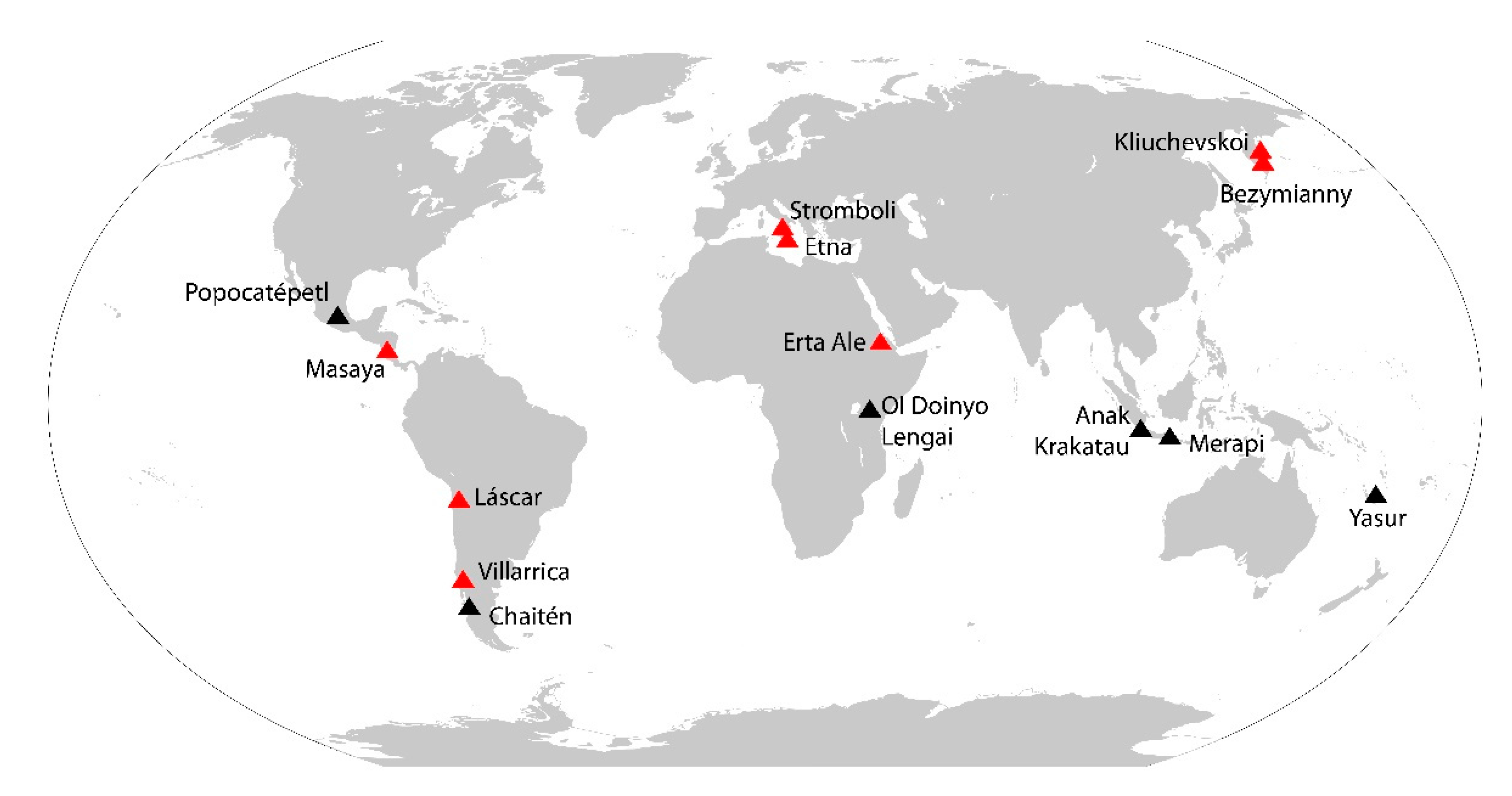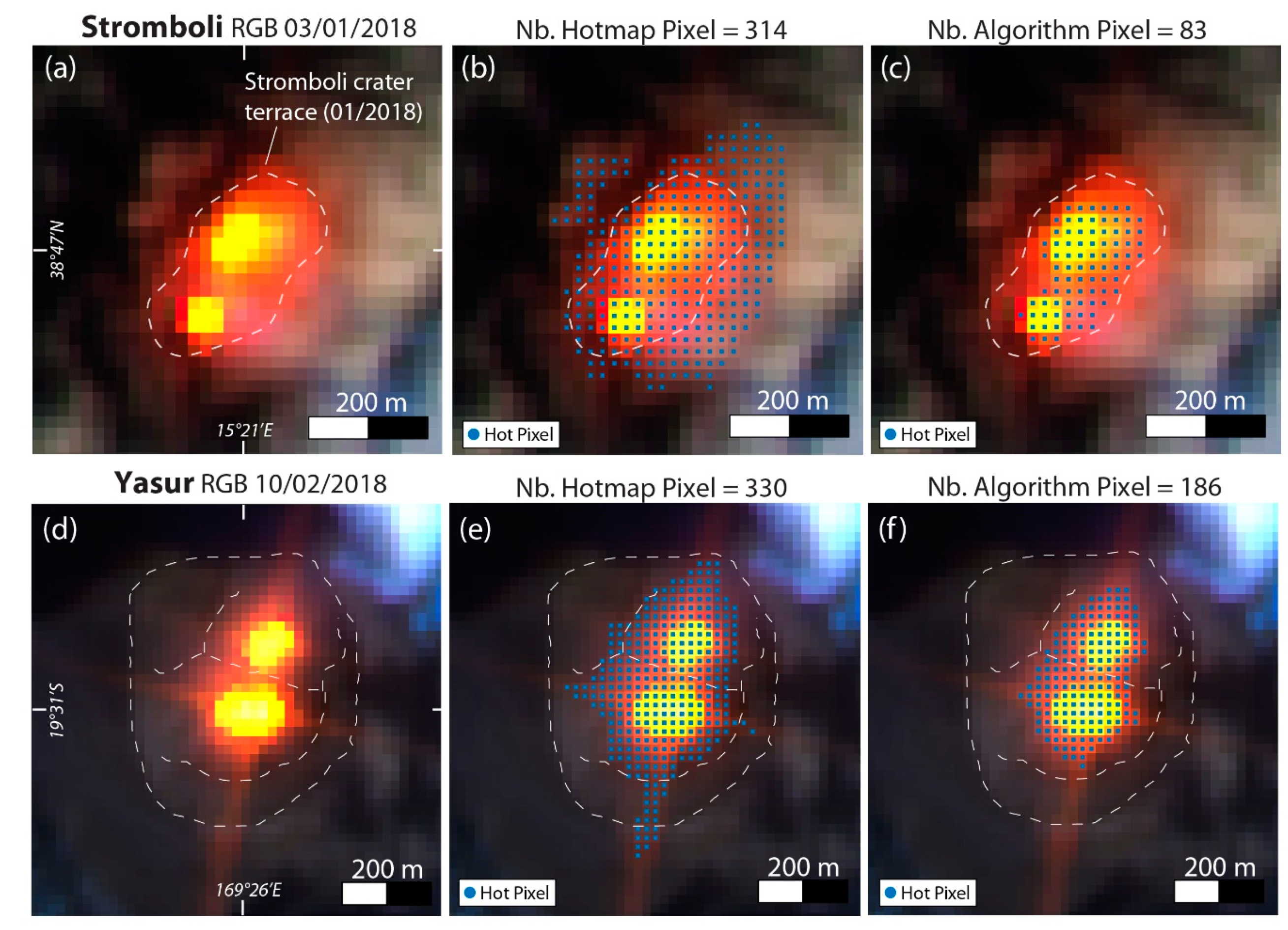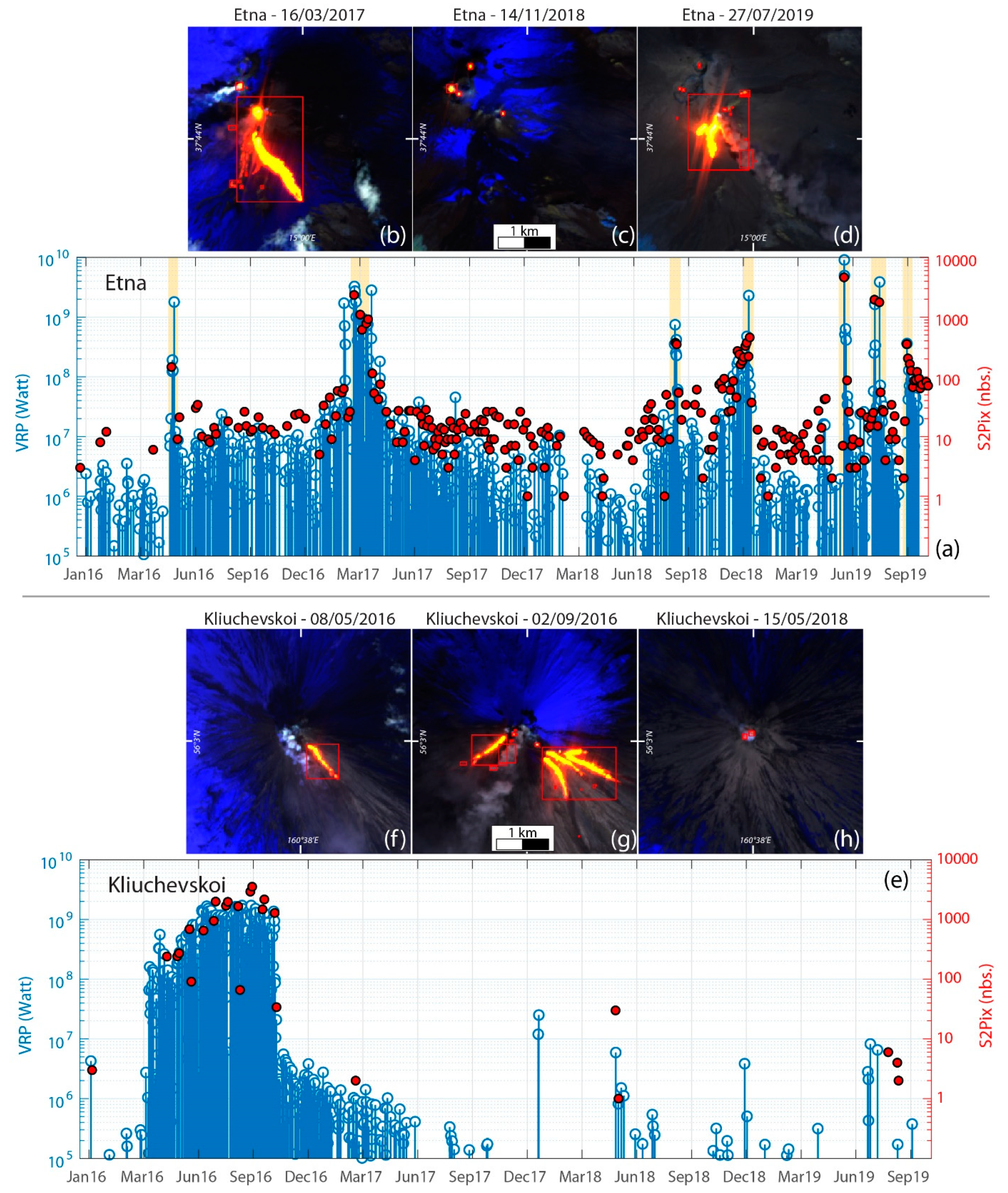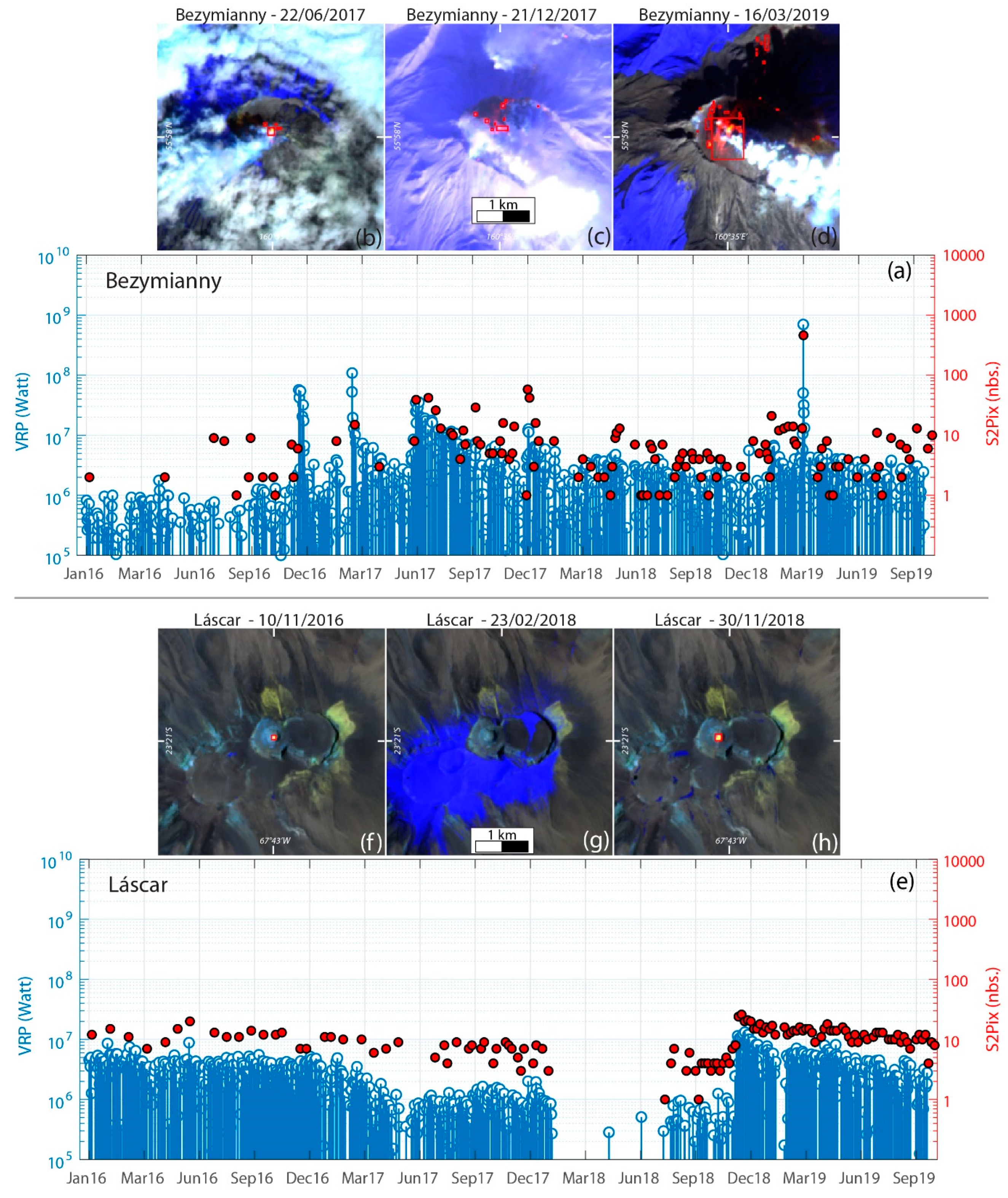Volcanic Hot-Spot Detection Using SENTINEL-2: A Comparison with MODIS–MIROVA Thermal Data Series
Abstract
1. Introduction
2. Products and Methods
2.1. SENTINEL-2 Products
2.2. Data Access
2.3. Hot-Spot Algorithm
2.3.1. Step 1: Spectral Principles
2.3.2. Step 2: Thermal Index
2.3.3. Step 3: Spatial and Statistical Principles
3. Results
3.1. S2 Algorithm Evaluation
- (i)
- True volcanic alert: a pixel anomaly detected by the algorithm which is expressly and visually related to volcanic activity (hot degassing, lava body exposed, hot eruptive materials exposed and possibly confirmed by literature or consistent with the background knowledge of volcano activity) and that shows a visible thermal glowing (from dark-red to bright-white in color);
- (ii)
- Fires or anthropogenic alert: a pixel anomaly detected by the algorithm expressly and visually related to wildfire occurrence and/or located near of human-settled areas (usually these latter anomalies could be far from the source of volcanic activity, show dark-red tonalities and have a very small areal extent of 1–2 pixels);
- (iii)
- False alert: a pixel anomaly detected by the algorithm, visually related to cloud coverage, secondary cloud fringes and reflections effects over hot sources (also volcanic), blurring, high-reflectivity effects of land/sea surfaces;
- (iv)
- S2-MSI-derived false alert: a pixel anomaly detected by the algorithm and visually triggered by abnormal colored pixels related to stripe artifacts of the MSI sensor.
3.2. SENTINEL-2 and MODIS–MIROVA Timeseries Comparison
4. Discussion
5. Strengths and Limits
5.1. High-Spatial-Resolution Sensitivity
5.2. Reflection Effects and False Anomalies
6. Conclusions and Perspectives
Author Contributions
Funding
Acknowledgments
Conflicts of Interest
References
- Gawarecki, S.J.; Lyon, R.J.P.; Nordberg, W. Infrared spectral returns and imagery of the Earth from space and their application to geological problems. Sci. Technol. Ser. Am. Astron. Soc. 1965, 4, 13–33. [Google Scholar]
- Yokoyama, I. Heat and mass transfer through volcanoes. Riv. Ital. Geofis. 1972, 21, 165–169. [Google Scholar]
- Francis, P.W. Infra-red techniques for volcano monitoring and prediction—A review. J. Geol. Soc. Lond. 1979, 136, 355–359. [Google Scholar] [CrossRef]
- Oppenheimer, C. Volcanological applications of meteorological satellites. Int. J. Remote Sens. 1998, 19, 2829–2864. [Google Scholar] [CrossRef]
- Harris, A.J.L.; Baloga, S.M. Lava discharge rates from satellite-measured heat flux. Geophys. Res. Lett. 2009, 36, L19302. [Google Scholar] [CrossRef]
- Wright, R.; Flynn, L.P. On the retrieval of lava-flow surface temperatures from infrared satellite data. Geology 2003, 31, 893–896. [Google Scholar] [CrossRef]
- Francis, P.W.; Oppenheimer, C.; Stevenson, D. Endogenous growth of persistently active volcanoes. Nature 1993, 366, 554–557. [Google Scholar] [CrossRef]
- Aiuppa, A.; de Moor, J.M.; Arellano, S.; Coppola, D.; Francofonte, V.; Galle, B.; Giudice, G.; Liuzzo, M.; Mendoza, E.; Saballos, A.; et al. Tracking formation of a lava lake from ground and space: Masaya volcano (Nicaragua), 2014–2017. Geochem. Geophys. Geosyst. 2018, 19, 496–515. [Google Scholar] [CrossRef]
- Oppenheimer, C.; Francis, P.W.; Rothery, D.A.; Carlton, R.W.T.; Glaze, L.S. Infrared image analysis of volcanic thermal features: Lascar volcano, Chile, 1984–1992. J. Geophys. Res. 1993, 98, 4269–4286. [Google Scholar] [CrossRef]
- Werner, C.; Kern, C.; Coppola, D.; Lyons, J.J.; Kelly, P.J.; Wallace, K.L.; Schneider, D.J.; Wessels, R.L. Magmatic degassing, lava dome extrusion, and explosions from Mount Cleveland volcano, Alaska, 2011–2015: Insight into the continuous nature of volcanic activity over multi-year timescales. J. Volcanol. Geotherm. Res. 2017, 337, 98–110. [Google Scholar] [CrossRef]
- Ripepe, M.; Pistolesi, M.; Coppola, D.; Delle Donne, D.; Genco, R.; Lacanna, G.; Laiolo, M.; Marchetti, E.; Ulivieri, G.; Valade, S. Forecasting effusive dynamic and decompression rates by magmastatic model at open-vent volcanoes. Sci. Rep. 2017, 7, 3885. [Google Scholar] [CrossRef] [PubMed]
- Coppola, D.; Ripepe, M.; Laiolo, M.; Cigolini, C. Modelling satellite-derived magma discharge to explain caldera collapse. Geology 2017, 45, 523–526. [Google Scholar] [CrossRef]
- D’Aleo, R.; Bitetto, M.; Delle Donne, D.; Coltelli, M.; Coppola, D.; McCormick Kilbride, B.; Pecora, E.; Ripepe, M.; Salem, L.C.; Tamburello, G.; et al. Understanding the SO2 Degassing Budget of Mt Etna’s Paroxysms: First Clues from the December 2015 Sequence. Front. Earth Sci. 2018, 6, 239. [Google Scholar] [CrossRef]
- Coppola, D.; Laiolo, M.; Massimetti, F.; Cigolini, C. Monitoring endogenous growth of open-vent volcanoes by balancing thermal and SO2 emissions data derived from space. Sci. Rep. 2019, 9, 9394. [Google Scholar] [CrossRef] [PubMed]
- Harris, A.J.L.; Stevenson, D.S. Thermal observations of degassing open conduits and fumaroles at Stromboli and Vulcano using remotely sensed data. J. Volcanol. Geotherm. Res. 1997, 76, 175–198. [Google Scholar] [CrossRef]
- Mia, M.B.; Fujimitsu, Y.; Nishijima, J. Thermal Activity Monitoring of an Active Volcano Using Landsat 8/OLI-TIRS Sensor Images: A Case Study at the Aso Volcanic Area in Southwest Japan. Geosciences 2017, 7, 118. [Google Scholar] [CrossRef]
- Cigolini, C.; Coppola, D.; Yokoo, A.; Laiolo, M. The thermal signature of Aso Volcano during unrest episodes detected from space and ground-based measurements. Earth Planets Space 2018, 70, 67. [Google Scholar] [CrossRef]
- Ramsey, M.; Harris, A. Volcanology 2020: How will thermal remote sensing of volcanic surface activity evolve over the next decade? J. Volcanol. Geotherm. Res. 2013, 249, 217–233. [Google Scholar]
- Harris, A.J.L.; Villeneuve, N.; Di Muro, A.; Ferrazzini, V.; Peltier, A.; Coppola, D.; Favalli, M.; Bachèlery, P.; Froger, J.-L.; Gurioli, L.; et al. Effusive crises at Piton de la Fournaise 2014–2015: A review of a multi-national response model. J. Appl. Volcanol. 2017, 6, 11. [Google Scholar] [CrossRef]
- Coppola, D.; Laiolo, M.; Cigolini, C.; Massimetti, F.; Delle Donne, D.; Ripepe, M.; Arias, H.; Barsotti, S.; Parra, C.B.; Centeno, R.G.; et al. Thermal remote sensing for global volcano monitoring: Experiences from the MIROVA system. Front. Earth Sci. 2019, 7, 362. [Google Scholar] [CrossRef]
- Blackett, M. An overview of infrared remote sensing of volcanic activity. J. Imaging 2017, 3, 13. [Google Scholar] [CrossRef]
- Wright, R.; Flynn, L.P.; Garbeil, H.; Harris, A.J.L.; Pilger, E. MODVOLC: Near-real-time thermal monitoring of global volcanism. J. Volcanol. Geotherm. Res. 2004, 135, 29–49. [Google Scholar] [CrossRef]
- Ganci, G.; Bilotta, G.; Cappello, A.; Hérault, A.; Del Negro, C. HOTSAT: A multiplatform system for the satellite thermal monitoring of volcanic activity. Geol. Soc. Lond. Spec. Publ. 2016, 426, 207–221. [Google Scholar] [CrossRef]
- Gouhier, M.; Guéhenneux, Y.; Labazuy, P.; Cacault, P.; Decriem, J.; Rivet, S. HOTVOLC: A web-based monitoring system for volcanic hot spots. Geol. Soc. Lond. Spec. Publ. 2016, 426, 223–241. [Google Scholar] [CrossRef]
- Coppola, D.; Laiolo, M.; Cigolini, C.; Delle Donne, D.; Ripepe, M. Enhanced volcanic hot-spot detection using MODIS IR data: Results from the MIROVA system. Geol. Soc. Lond. Spec. Publ. 2016, 426, 181–205. [Google Scholar] [CrossRef]
- Wright, R.; Flynn, L.; Garbeil, H.; Harris, A.J.L.; Pilger, E. Automated volcanic eruption detection using MODIS. Remote Sens. Environ. 2002, 82, 135–155. [Google Scholar] [CrossRef]
- Harris, A.J.L. Thermal Remote Sensing of Active Volcanoes. A User’s Manual; Cambridge University Press: Cambridge, UK, 2013; p. 736. [Google Scholar]
- Rothery, D.A.; Coppola, D.; Saunders, C. Analysis of volcanic activity patterns using MODIS thermal alerts. Bull. Volcanol. 2005, 67, 539–556. [Google Scholar] [CrossRef]
- Steffke, A.M.; Harris, A.J.L. A review of algorithms for detecting volcanic hot spots in satellite infrared data. Bull. Volcanol. 2011, 73, 1109–1137. [Google Scholar] [CrossRef]
- Valade, S.; Ley, A.; Massimetti, F.; D’Hondt, O.; Laiolo, M.; Coppola, D.; Loibl, D.; Hellwich, O.; Walter, T.R. Towards Global Volcano Monitoring Using Multisensor Sentinel Missions and Artificial Intelligence: The MOUNTS Monitoring System. Remote Sens. 2019, 11, 1528. [Google Scholar] [CrossRef]
- Marchese, F.; Neri, M.; Falconieri, A.; Lacava, T.; Mazzeo, G.; Pergola, N.; Tramutoli, V. The Contribution of Multi-Sensor Infrared Satellite Observations to Monitor Mt. Etna (Italy) Activity during May to August 2016. Remote Sens. 2018, 10, 1948. [Google Scholar] [CrossRef]
- Blackett, M. Early analysis of Landsat-8 thermal infrared sensor imagery of volcanic activity. Remote Sens. 2014, 6, 2282–2295. [Google Scholar] [CrossRef]
- Mia, M.; Fujimitsu, Y.; Nishijima, J. Monitoring of Thermal Activity at the Hatchobaru–Otake Geothermal Area in Japan Using Multi-Source Satellite Images—With Comparisons of Methods, and Solar and Seasonal Effects. Remote Sens. 2018, 10, 1430. [Google Scholar] [CrossRef]
- Ramsey, M.S. Synergistic Use of Satellite Thermal Detection and Science: A Decadal Perspective Using ASTER. Geol. Soc. Spec. Publ. 2016, 426, 115–136. [Google Scholar] [CrossRef]
- Reath, K.; Pritchard, M.; Moruzzi, S.; Alcott, A.; Coppola, D.; Pieri, D. The AVTOD (ASTER Volcano Thermal Output Database) Latin America Archive. J. Volcanol. Geotherm. Res. 2019, 376, 62–74. [Google Scholar] [CrossRef]
- Drusch, M.; Del Bello, U.; Carlier, S.; Colin, O.; Fernandez, V.; Gascon, F.; Hoersch, B.; Isola, C.; Laberinti, P.; Martimort, P. Sentinel-2: ESA’s optical high-resolution mission for GMES operational services. Remote Sens. Environ. 2012, 120, 25–36. [Google Scholar] [CrossRef]
- Laiolo, M.; Ripepe, M.; Cigolini, C.; Coppola, D.; Della Schiava, M.; Genco, R.; Innocenti, L.; Lacanna, G.; Marchetti, E.; Massimetti, F.; et al. Space-and Ground-Based Geophysical Data Tracking of Magma Migration in Shallow Feeding System of Mount Etna Volcano. Remote Sens. 2019, 11, 1182. [Google Scholar] [CrossRef]
- Plank, S.; Walter, T.R.; Martinis, S.; Cesca, S. Growth and collapse of a littoral lava dome during the 2018/19 eruption of Kadovar Volcano, Papua New Guinea, analyzed by multi-sensor satellite imagery. J. Volcanol. Geotherm. Res. 2019, 388, 106704. [Google Scholar] [CrossRef]
- Plank, S.; Marchese, F.; Filizzola, C.; Pergola, N.; Neri, M.; Nolde, M.; Martinis, S. The July/August 2019 Lava Flows at the Sciara del Fuoco, Stromboli–Analysis from Multi-Sensor Infrared Satellite Imagery. Remote Sens. 2019, 11, 2879. [Google Scholar] [CrossRef]
- Corradino, C.; Ganci, G.; Cappello, A.; Bilotta, G.; Hérault, A.; Del Negro, C. Mapping Recent Lava Flows at Mount Etna Using Multispectral Sentinel-2 Images and Machine Learning Techniques. Remote Sens. 2019, 11, 1916. [Google Scholar] [CrossRef]
- Aufaristama, M.; Hoskuldsson, A.; Jonsdottir, I.; Ulfarsson, M.O.; Erlangga, I.G.D.. Thordarson, T. Thermal model of lava in Mt. Agung during December 2017 episodes derived from Integrated SENTINEL 2A and ASTER remote sensing datasets. In Proceedings of the IOP Conference Series: Earth and Environmental Science; Padjadjaran Earth Dialogues, International Symposium on Geophysical Issues, Bandung, Indonesia, 2–4 July 2018; Volume 311, p. 012016. [Google Scholar]
- Gray, D.M.; Burton-Johnson, A.; Fretwell, P.T. Evidence for a lava lake on Mt. Michael volcano, Saunders Island (South Sandwich Islands) from Landsat, Sentinel-2 and ASTER satellite imagery. J. Volcanol. Geotherm. Res. 2019, 379, 60–71. [Google Scholar] [CrossRef]
- Murphy, S.W.; de Souza Filho, C.R.; Wright, R.; Sabatino, G.; Pabon, R.C. HOTMAP: Global hot target detection at moderate spatial resolution. Remote Sens. Environ. 2016, 177, 78–88. [Google Scholar] [CrossRef]
- Giglio, L.; Csiszar, I.; Restás, Á.; Morisette, J.T.; Schroeder, W.; Morton, D.; Justice, C.O. Active fire detection and characterization with the advanced spaceborne thermal emission and reflection radiometer (ASTER). Remote Sens. Environ. 2008, 112, 3055–3063. [Google Scholar] [CrossRef]
- Schroeder, W.; Oliva, P.; Giglio, L.; Quayle, B.; Lorenz, E.; Morelli, F. Active fire detection using landsat-8/OLI data. Remote Sens. Environ. 2016, 185, 210–220. [Google Scholar] [CrossRef]
- Roteta, E.; Bastarrika, A.; Padilla, M.; Storm, T.; Chuvieco, E. Development of a Sentinel-2 burned area algorithm: Generation of a small fire database for sub-Saharan Africa. Remote Sens. Environ. 2019, 222, 1–17. [Google Scholar] [CrossRef]
- Marchese, F.; Genzano, N.; Neri, M.; Falconieri, A.; Mazzeo, G.; Pergola, N. A Multi-Channel Algorithm for Mapping Volcanic Thermal Anomalies by Means of Sentinel-2 MSI and Landsat-8 OLI Data. Remote Sens. 2019, 11, 2876. [Google Scholar] [CrossRef]
- Blackett, M.; Wooster, M.J. Evaluation of SWIR-based methods for quantifying active volcano radiant emissions using NASA EOS-ASTER data. Geomat. Nat. Haz. Risk 2:1 2011, 2, 51–78. [Google Scholar] [CrossRef]
- ESA Sentinel Online. Missions, SENTINEL 2. Available online: https://sentinel.esa.int/web/sentinel/missions/sentinel-2 (accessed on 11 December 2019).
- Li, J.; Roy, D.P. A Global Analysis of Sentinel-2A, Sentinel-2B and Landsat-8 Data Revisit Intervals and Implications for Terrestrial Monitoring. Remote Sens. 2017, 9, 902. [Google Scholar]
- ESA Sentinel Online. User Guides. Sentinel-2 MSI. Available online: https://sentinel.esa.int/web/sentinel/user-guides/sentinel-2-msi (accessed on 11 December 2019).
- Copernicus Open Access Hub. Available online: https://scihub.copernicus.eu/dhus/#/home (accessed on 11 December 2019).
- AWS S3. Registry of Open Data on AWS. Available online: https://registry.opendata.aws/ (accessed on November 2019).
- AWS Documentation. Requester Pays Buckets. Available online: https://docs.aws.amazon.com/AmazonS3/latest/dev/sRequesterPaysBuckets.html (accessed on November 2019).
- Global Volcanism Program. In Volcanoes of the World; Venzke, E., Ed.; Smithsonian Institution: Washington, DC, USA, 2013; Available online: https://doi.org/10.5479/si.GVP.VOTW4-2013 (accessed on 2 March 2020).
- Sterckx, S.; Knaeps, S.; Kratzer, S.; Ruddick, K. SIMilarity Environment Correction (SIMEC) applied to MERIS data over inland and coastal waters. Remote Sens. Environ. 2015, 157, 96–110. [Google Scholar] [CrossRef]
- Global Volcanism Program. In Volcanoes of the World; Chaitén (358041), Vision 4.8.5; Venzke, E., Ed.; Smithsonian Institution: Washington, DC, USA, 2013; Available online: https://volcano.si.edu/volcano.cfm?vn=358041 (accessed on 11 December 2019). [CrossRef]
- Global Volcanism Program. In Volcanoes of the World; Krakatau (262000), Vision 4.8.5; Venzke, E., Ed.; Smithsonian Institution: Washington, DC, USA, 2013; Available online: https://volcano.si.edu/volcano.cfm?vn=262000 (accessed on 11 December 2019). [CrossRef]
- Walter, T.R.; Haghshenas Haghighi, M.; Schneider, F.M.; Coppola, D.; Motagh, M.; Saul, J.; Babeyko, A.; Dahm, T.; Troll, V.R.; Tilmann, F.; et al. Complex hazard cascade culminating in the Anak Krakatau sector collapse. Nat. Commun. 2019, 10, 4339. [Google Scholar] [CrossRef]
- Global Volcanism Program. In Volcanoes of the World; Erta Ale (221080), Vision 4.8.5; Venzke, E., Ed.; Smithsonian Institution: Washington, DC, USA, 2013; Available online: https://volcano.si.edu/volcano.cfm?vn=221080 (accessed on 11 December 2019). [CrossRef]
- Global Volcanism Program. In Volcanoes of the World; Etna (211060), Vision 4.8.5; Venzke, E., Ed.; Smithsonian Institution: Washington, DC, USA, 2013; Available online: https://volcano.si.edu/volcano.cfm?vn=211060 (accessed on 11 December 2019). [CrossRef]
- Global Volcanism Program. In Volcanoes of the World; Stromboli (211040), Vision 4.8.5; Venzke, E., Ed.; Smithsonian Institution: Washington, DC, USA, 2013; Available online: https://volcano.si.edu/volcano.cfm?vn=211040 (accessed on 11 December 2019). [CrossRef]
- Global Volcanism Program. In Volcanoes of the World; Yasur (341090), Vision 4.8.5; Venzke, E., Ed.; Smithsonian Institution: Washington, DC, USA, 2013; Available online: https://volcano.si.edu/volcano.cfm?vn=341090 (accessed on 11 December 2019). [CrossRef]
- Global Volcanism Program. In Volcanoes of the World; Klyuchevskoy (300260), Vision 4.8.5; Venzke, E., Ed.; Smithsonian Institution: Washington, DC, USA, 2013; Available online: https://volcano.si.edu/volcano.cfm?vn=300260 (accessed on 11 December 2019). [CrossRef]
- Global Volcanism Program. In Volcanoes of the World; Masaya (344100), Vision 4.8.5; Venzke, E., Ed.; Smithsonian Institution: Washington, DC, USA, 2013; Available online: https://volcano.si.edu/volcano.cfm?vn=344100 (accessed on 11 December 2019). [CrossRef]
- Global Volcanism Program. In Volcanoes of the World; Villarrica (357120), Vision 4.8.5; Venzke, E., Ed.; Smithsonian Institution: Washington, DC, USA, 2013; Available online: https://volcano.si.edu/volcano.cfm?vn=357120 (accessed on 11 December 2019). [CrossRef]
- Global Volcanism Program. In Volcanoes of the World; Bezymianny (300250), Vision 4.8.5; Venzke, E., Ed.; Smithsonian Institution: Washington, DC, USA, 2013; Available online: https://volcano.si.edu/volcano.cfm?vn=300250 (accessed on 11 December 2019). [CrossRef]
- Global Volcanism Program. In Volcanoes of the World; Láscar (355100), Vision 4.8.5; Venzke, E., Ed.; Smithsonian Institution: Washington, DC, USA, 2013; Available online: https://volcano.si.edu/volcano.cfm?vn=355100 (accessed on 11 December 2019). [CrossRef]
- ESA Sentinel Online. User Guides. Sentinel-2 MSI. S2-MSI Document Library. Sentinel-2 L1C Data Quality Report Issue 48 (February 2020). Available online: https://sentinel.esa.int/documents/247904/685211/Sentinel-2_L1C_Data_Quality_Report (accessed on January 2020).
- Wooster, M.J.; Zhukov, B.; Oertel, D. Fire radiative energy for quantitative study of biomass burning: Derivation from the BIRD experimental satellite and comparison to MODIS fire products. Remote Sens. Environ. 2003, 86, 83–107. [Google Scholar] [CrossRef]
- Barnie, T.D.; Oppenheimer, C.; Pagli, C. Does the lava lake of Erta‘Ale volcano respond to regional magmatic and tectonic events? An investigation using Earth Observation data. Geol. Soc. Lond. Spec. Publ. 2016, 420, 181–208. [Google Scholar] [CrossRef]
- Moore, C.; Wright, T.; Hooper, A.; Biggs, J. The 2017 eruption of Erta ’Ale Volcano, Ethiopia: Insights into the shallow axial plumbing system of an incipient mid-ocean ridge. Geochem. Geophys. Geosyst. 2019, 20, 5727–5743. [Google Scholar] [CrossRef]
- Pering, T.D.; Ilanko, T.; Wilkes, T.C.; England, R.A.; Silcock, S.R.; Stanger, L.R.; Willmott, J.R.; Bryant, R.G.; McGonigle, A.J.S. A Rapidly Convecting Lava Lake at Masaya Volcano, Nicaragua. Front. Earth Sci. 2019, 6, 241. [Google Scholar] [CrossRef]
- Rose, W.I.; Palma, J.L.; Delgado Granados, H.; Varley, N. Open-vent volcanism and related hazards: Overview. Geol. Soc. Lond. Spec. Publ. 2013, 498, 7–13. [Google Scholar]
- Coppola, D.; Piscopo, D.; Laiolo, M.; Cigolini, C.; Delle Donne, D.; Ripepe, M. Radiative heat power at Stromboli volcano during 2000–2011: Twelve years of MODIS observations. J. Volcanol. Geotherm. Res. 2012, 215, 48–60. [Google Scholar] [CrossRef]
- Palma, J.L.; Calder, E.S.; Basualto, D.; Blake, S.; Rothery, D.A. Correlations between SO2 flux, seismicity, and outgassing activity at the open vent of Villarrica volcano, Chile. J. Geophys. Res. 2008, 113, B10201. [Google Scholar] [CrossRef]
- Global Volcanism Program. In Volcanoes of the World; Merapi (263250), Vision 4.8.5; Venzke, E., Ed.; Smithsonian Institution: Washington, DC, USA, 2013; Available online: https://volcano.si.edu/volcano.cfm?vn=263250 (accessed on 11 December 2019). [CrossRef]
- Global Volcanism Program. In Volcanoes of the World; Ol Doinyo Lengai (222120), Vision 4.8.5; Venzke, E., Ed.; Smithsonian Institution: Washington, DC, USA, 2013; Available online: https://volcano.si.edu/volcano.cfm?vn=222120 (accessed on 11 December 2019). [CrossRef]
- Pallister, J.S.; Schneider, D.J.; Griswold, J.P.; Keeler, R.H.; Burton, W.C.; Noyles, C.; Newhall, C.G.; Ratdomopurbo, A. Merapi 2010 eruption—Chronology and extrusion rates monitored with satellite radar and used in eruption forecasting. J. Volcanol. Geotherm. Res. 2013, 261, 144–152. [Google Scholar] [CrossRef]
- Surono, M.; Jousset, P.; Pallister, J.; Boichu, M.; Buongiorno, M.F.; Budisantoso, A.; Costa, F.; Andreastuti, S.; Prata, F.; Schneider, D.; et al. The 2010 explosive eruption of Java’s Merapi volcano—A ‘100-year’ event. J. Volcanol. Geotherm. Res. 2012, 241, 121–135. [Google Scholar] [CrossRef]
- Dawson, J.B.; Keller, J.; Nyamweru, C. Historic and recent eruptive activity of Oldoinyo Lengai. In Carbonatite Volcanism; Springer: Berlin/Heidelberg, Germany, 1995; Volume 4, pp. 4–22. [Google Scholar]
- Vaughan, R.G.; Kervyn, M.; Realmuto, V.; Abrams, M.; Hook, S.J. Satellite measurements of recent volcanic activity at Oldoinyo Lengai, Tanzania. J. Volcanol. Geotherm. Res. 2008, 173, 196–206. [Google Scholar] [CrossRef]
- Kervyn, M.; Ernst, G.G.J.; Harris, A.J.L.; Belton, F.; Mbede, E.; Jacobs, P. Thermal remote sensing of the low-intensity carbonatite volcanism of Oldoinyo Lengai, Tanzania. Int. J. Remote Sens. 2008, 29, 6467–6499. [Google Scholar] [CrossRef]
- Global Volcanism Program. In Volcanoes of the World; Nyiragongo (223030), Vision 4.8.5; Venzke, E., Ed.; Smithsonian Institution: Washington, DC, USA, 2013; Available online: https://volcano.si.edu/volcano.cfm?vn=223030 (accessed on 11 December 2019). [CrossRef]
- ESA Sentinel Online. Technical Guides. Sentinel-2 MSI. Cloud Masks. Available online: https://sentinel.esa.int/web/SENTINEL/technical-guides/SENTINEL-2-msi/level-1c/cloud-masks (accessed on January 2020).
- Global Volcanism Program. In Volcanoes of the World; Popocatépetl (257100), Vision 4.8.5; Venzke, E., Ed.; Smithsonian Institution: Washington, DC, USA, 2013; Available online: https://volcano.si.edu/volcano.cfm?vn=257100 (accessed on 11 December 2019). [CrossRef]
- Massimetti, F.; Coppola, D.; Laiolo, M.; Cigolini, C.; Ripepe, M. First comparative results from SENTINEL-2 and MODIS-MIROVA volcanic thermal dataseries. In Proceedings of the CoV10 IAVCEI General Assembly, Naples, Italy, 2–7 September 2018. [Google Scholar]















| Band Number | Resolution (m) | Central Wavelength (µm) | Purpose |
|---|---|---|---|
| Band 1 | 60 | 0.443 | Aerosol detection |
| Band 2 | 10 | 0.490 | Blue |
| Band 3 | 10 | 0.560 | Green |
| Band 4 | 10 | 0.665 | Red |
| Band 5 | 20 | 0.705 | Vegetation classification |
| Band 6 | 20 | 0.740 | Vegetation classification |
| Band 7 | 20 | 0.783 | Vegetation classification |
| Band 8 | 10 | 0.842 | Near Infrared |
| Band 8a | 20 | 0.865 | Vegetation classification (NIR/SWIR) |
| Band 9 | 60 | 0.945 | Water vapor |
| Band 10 | 60 | 1.375 | SWIR - Cirrus |
| Band 11 | 20 | 1.610 | SWIR |
| Band 12 | 20 | 2.190 | SWIR |
| VOLCANO | S2 Images 1 | Algorithm Alerts 2 | Algorithm Volcanic Alerts 3 | True Volcanic Alerts 4 | Missed Volcanic Alerts 5 | Successful Detection (%) 6 | Fires/Anthropogenic Alerts 7 |
| ETNA | 417 | 275 | 259 | 270 | 11 | 95.92% | 7 |
| KLIUCHEVSKOI | 337 | 29 | 25 | 29 | 4 | 86.21% | 0 |
| ERTA ALE | 207 | 190 | 190 | 197 | 7 | 96.44% | 0 |
| MASAYA | 166 | 124 | 117 | 120 | 3 | 97.50% | 16 |
| STROMBOLI | 243 | 134 | 128 | 132 | 4 | 96.96% | 7 |
| VILLARRICA | 337 | 184 | 183 | 186 | 3 | 98.38% | 1 |
| BEZYMIANNY | 338 | 126 | 118 | 137 | 19 | 86.13% | 0 |
| LÁSCAR | 166 | 116 | 116 | 120 | 4 | 96.66% | 0 |
| False Alerts | |||||||
| VOLCANO | Algorithm False Alerts 8 | Algorithm False Detection (%) 9 | S2-MSI derived False Alerts 10 | False Detection All (%) 11 | |||
| ETNA | 8 | 2.91% | 22 | 10.91% | |||
| KLIUCHEVSKOI | 1 | 3.45% | 3 | 13.78% | |||
| ERTA ALE | 0 | - | 0 | - | |||
| MASAYA | 0 | - | 2 | 1.61% | |||
| STROMBOLI | 2 | 1.49% | 0 | 1.49% | |||
| VILLARRICA | 0 | - | 0 | - | |||
| BEZYMIANNY | 1 | 0.79% | 7 | 6.34% | |||
| LÁSCAR | 0 | - | 0 | - | |||
© 2020 by the authors. Licensee MDPI, Basel, Switzerland. This article is an open access article distributed under the terms and conditions of the Creative Commons Attribution (CC BY) license (http://creativecommons.org/licenses/by/4.0/).
Share and Cite
Massimetti, F.; Coppola, D.; Laiolo, M.; Valade, S.; Cigolini, C.; Ripepe, M. Volcanic Hot-Spot Detection Using SENTINEL-2: A Comparison with MODIS–MIROVA Thermal Data Series. Remote Sens. 2020, 12, 820. https://doi.org/10.3390/rs12050820
Massimetti F, Coppola D, Laiolo M, Valade S, Cigolini C, Ripepe M. Volcanic Hot-Spot Detection Using SENTINEL-2: A Comparison with MODIS–MIROVA Thermal Data Series. Remote Sensing. 2020; 12(5):820. https://doi.org/10.3390/rs12050820
Chicago/Turabian StyleMassimetti, Francesco, Diego Coppola, Marco Laiolo, Sébastien Valade, Corrado Cigolini, and Maurizio Ripepe. 2020. "Volcanic Hot-Spot Detection Using SENTINEL-2: A Comparison with MODIS–MIROVA Thermal Data Series" Remote Sensing 12, no. 5: 820. https://doi.org/10.3390/rs12050820
APA StyleMassimetti, F., Coppola, D., Laiolo, M., Valade, S., Cigolini, C., & Ripepe, M. (2020). Volcanic Hot-Spot Detection Using SENTINEL-2: A Comparison with MODIS–MIROVA Thermal Data Series. Remote Sensing, 12(5), 820. https://doi.org/10.3390/rs12050820






